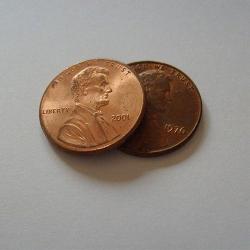Source Institutions
Source Institutions
Add to list Go to activity
Activity link broken? See if it's at the internet archive

Learners initially test to see how many drops of liquid (water, rubbing alcohol, and vegetable oil) can fit on a penny. They then generate their own hypotheses to explain the results and design experiments to test these hypotheses. Learners can actually conduct their experiments as time allows. This activity is a good opportunity to discuss details of experimental design and controlling variables.
- Under 5 minutes
- 10 to 30 minutes
- $1 - $5 per group of students
- Ages 11 - 14
- Activity, Experiment/Lab Activity, Lesson/Lesson Plan
- English
Quick Guide
Materials List (per group of students)
- Small beakers (50-100 ml) or plastic cups (about 4 to 8 ounces), three per team
- Disposable pipettes, one per student plus a few extras
- Pennies, one per student
- Rubbing (isopropyl) alcohol, two 16-ounce bottles
- Vegetable oil, one 32-ounce bottle
- Paper towels, several per student
- Water
Subjects
-
Engineering and Technology
- Engineering
-
Mathematics
-
Data Analysis and Probability
- Data Analysis
- Data Collection
- Data Representation
-
Measurement
- Units of Measurement
-
Data Analysis and Probability
-
Physical Sciences
-
Chemistry
- Solutions
-
States of Matter
- Liquids
- Structure and Properties of Matter
-
Chemistry
-
The Nature of Science
-
The Scientific Process
- About Inquiry
- Asking Questions
- Conducting Investigations
- Gathering Data
- Formulating Explanations
-
The Scientific Process
Audience
To use this activity, learners need to:
- see
- touch
Learning styles supported:
- Involves teamwork and communication skills
- Involves hands-on or lab activities
Other
Components that are part of this resource:
Includes alignment to state and/or national standards:
This resource is part of:
Access Rights:
- Free access
By:
- Hebrank, Mary R.
Source Collection
- TeachEngineering
Rights:
- All rights reserved, Regents of the University of Colorado, 2013
